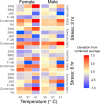This is a preprint.
Thermal tolerance of mosquito eggs is associated with urban adaptation and human interactions
- PMID: 38585904
- PMCID: PMC10996485
- DOI: 10.1101/2024.03.22.586322
Thermal tolerance of mosquito eggs is associated with urban adaptation and human interactions
Update in
-
Thermal tolerance of Aedes aegypti mosquito eggs is associated with urban adaptation and human interactions.J Therm Biol. 2025 Jul;131:104167. doi: 10.1016/j.jtherbio.2025.104167. Epub 2025 Jun 12. J Therm Biol. 2025. PMID: 40602174
Abstract
Climate change is expected to profoundly affect mosquito distributions and their ability to serve as vectors for disease, specifically with the anticipated increase in heat waves. The rising temperature and frequent heat waves can accelerate mosquito life cycles, facilitating higher disease transmission. Conversely, higher temperatures could increase mosquito mortality as a negative consequence. Warmer temperatures are associated with increased human density, suggesting a need for anthropophilic mosquitoes to adapt to be more hardy to heat stress. Mosquito eggs provide an opportunity to study the biological impact of climate warming as this stage is stationary and must tolerate temperatures at the site of female oviposition. As such, egg thermotolerance is critical for survival in a specific habitat. In nature, Aedes mosquitoes exhibit different behavioral phenotypes, where specific populations prefer depositing eggs in tree holes and prefer feeding non-human vertebrates. In contrast, others, particularly human-biting specialists, favor laying eggs in artificial containers near human dwellings. This study examined the thermotolerance of eggs, along with adult stages, for Aedes aegypti and Ae. albopictus lineages associated with known ancestry and shifts in their relationship with humans. Mosquitoes collected from areas with higher human population density, displaying increased human preference, and having a human-associated ancestry profile have increased egg viability following high-temperature stress. Unlike eggs, thermal tolerance among adults showed no significant correlation based on the area of collection or human-associated ancestry. This study highlights that the egg stage is likely critical to mosquito survival when associated with humans and needs to be accounted when predicting future mosquito distribution.
Keywords: Aedes sp.; ecological correlation; egg hatching index; egg survival; heat tolerance; human density; mosquitoes.
Conflict of interest statement
Declaration of competing interest - The authors declare no conflicts of interest.
Figures





Similar articles
-
Thermal tolerance of Aedes aegypti mosquito eggs is associated with urban adaptation and human interactions.J Therm Biol. 2025 Jul;131:104167. doi: 10.1016/j.jtherbio.2025.104167. Epub 2025 Jun 12. J Therm Biol. 2025. PMID: 40602174
-
Impact of temperature on survival, development and longevity of Aedes aegypti and Aedes albopictus (Diptera: Culicidae) in Phnom Penh, Cambodia.Parasit Vectors. 2025 Aug 27;18(1):362. doi: 10.1186/s13071-025-06892-y. Parasit Vectors. 2025. PMID: 40867007 Free PMC article.
-
Sexual Harassment and Prevention Training.2024 Mar 29. In: StatPearls [Internet]. Treasure Island (FL): StatPearls Publishing; 2025 Jan–. 2024 Mar 29. In: StatPearls [Internet]. Treasure Island (FL): StatPearls Publishing; 2025 Jan–. PMID: 36508513 Free Books & Documents.
-
The Black Book of Psychotropic Dosing and Monitoring.Psychopharmacol Bull. 2024 Jul 8;54(3):8-59. Psychopharmacol Bull. 2024. PMID: 38993656 Free PMC article. Review.
-
Management of urinary stones by experts in stone disease (ESD 2025).Arch Ital Urol Androl. 2025 Jun 30;97(2):14085. doi: 10.4081/aiua.2025.14085. Epub 2025 Jun 30. Arch Ital Urol Androl. 2025. PMID: 40583613 Review.
References
-
- Ajayi O. M., Oyen K. J., Davies B., Finch G., Piller B. D., Harmeyer A. A., Wendeln K., Perretta C., Rosendale A. J., & Benoit J. B. (2023). Egg hatching success is influenced by the time of thermal stress in four hard tick species. Journal of Medical Entomology. 10.1093/jme/tjad142 - DOI - PMC - PubMed
-
- Akhtar R., Gupta P. T., & Srivastava A. K. (2016). Urbanization, Urban Heat Island Effects and Dengue Outbreak in Delhi. In Akhtar R. (Ed.), Climate Change and Human Health Scenario in South and Southeast Asia (pp. 99–111). Springer International Publishing.
-
- Aubry F., Dabo S., Manet C., Filipović I., Rose N. H., Miot E. F., Martynow D., Baidaliuk A., Merkling S. H., Dickson L. B., Crist A. B., Anyango V. O., Romero-Vivas C. M., Vega-Rúa A., Dusfour I., Jiolle D., Paupy C., Mayanja M. N., Lutwama J. J., … Lambrechts L. (2020). Enhanced Zika virus susceptibility of globally invasive populations. Science, 370(6519), 991–996. - PubMed
-
- Becker R. A., Chambers J. M., & Wilks A. R. (1988). The New S Language: A Programming Environment for Data Analysis and Graphics (Wadsworth & Brooks/Cole Advanced Books & Software, London).
Publication types
Grants and funding
LinkOut - more resources
Full Text Sources
Research Materials
